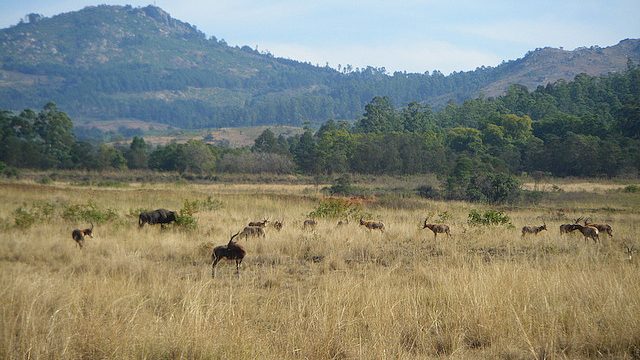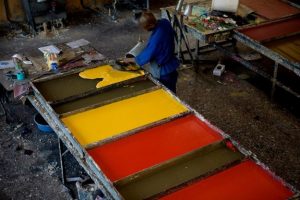Culturally vibrant and visually appealing, Africa’s last remaining monarchy may be small, but it packs a potent punch for visitors. From sublime handicrafts (different than what you’ll see in South Africa) to unique safaris, Swaziland’s Ezulwini Valley is home not only to the royal family, but also to plenty of ways to keep busy for 48 hours. Here’s how we’d spend our time in the region:
Day 1
Skip the capital, Mbabane, which has little to entice tourists and continue south for about 12 km to the Ezulwini Valley. This is Swaziland’s traditional royal heartland, and also where most of its tourism infrastructure is concentrated.
Cruise the old MR103 access road to explore this lush valley filled with flowering jacarandas and bright orange flame trees. Beyond the beautiful woodland scenery, the Valley of Heaven (as Ezulwini translates in English) is home to some excellent places to spend the night in the countryside and also the country’s best handicraft shopping.
Begin with the shopping. Since the valley is so small – it’s easy to drive around the entire country in a day – it is easy to hit up the best handicraft markets in a leisurely morning.
Heading south from Mbabane the first craft market you’ll reach in the valley is along the side of the MR103 just south of the Ezulwini Sun Hotel. It sells a variety of wooden and stone carved pieces plus hand-woven and beaded baskets. If you’re hungry, grab a snack at the lovely Woodlands Restaurant, which has a shady verandah for dining and a menu featuring international fare and vegetarian choices.
From here continue just a few kilometers south – it is well signposted – to the Mantenga Craft Center on the access road leading to Mantenga Lodge. It has a number of shops featuring everything from the famously colorful Swazi candles and carved metal holders to wood carvings, tapestries and even locally produced T-shirts. Just across the street Guava Gallery is a chic boutique that sells high quality, locally made product. Have lunch at the attacked Guava Café, which is a chic eatery serving decent salads, soups, sandwiches.
From here continue south to Lobamba village, which is the seat of the Swazi monarchy. The royal Embo State Palace was built in grand proportions by the British to house the entire Swazi royal family at one time. It isn’t always open to the public, however, and photos are not allowed. The royal family no longer lives here either – they are now entrenched at the Lozitha State House, located about 10 km from here. If you want to get a feel for Swaziland’s history, however, you can head to the National Museum for the full scoop.
Spend the rest of the afternoon meandering through the adjoining Malkerns Valley – the turn-off is located about 7 km south of Lobamba on the MR103. Besides being easy on the eyes, this valley is also known for it’s shopping (don’t worry it is different than what you saw in the morning) and where you’ll spend the night.
Swaziland is famous for its colorful handmade candles that come in every kind of African animal shape — and plenty of non animal shapes — imaginable, so before taking the turnoff into the valley, continue south for another 7 km on the MR103 to the Swazi Candles Craft Center, which is the best place to buy the creative colored wax in the kingdom. Also on the premises is the Umgololo Gallery, which sells different style of handicrafts. You can grab a coffee at the onsite shop before continuing on to the Malandela complex, which is where you’ll spend the night.
Check into Malandela’s B&B, part of the complex, which includes a restaurant, shops and even a music venue, located about a kilometer from the MR103 junction on the MR27. It offers the most eclectic lodging in the region with stylish and creatively furnished rooms boasting an African flair. The B&B is also known for serving an amazing breakfast, and there is a swimming pool to cool off in and a sculpture garden to Zen out in.
If you haven’t had your fill of shopping check out Gone Rural for woven baskets, mats and traditional clay pots and Baobab Batik for bright bolts of hand printed cloth.
Grab dinner at Malandela’s Restaurant in the complex, which is one of the best in the region and serves a range of meat and seafood dishes – ask for a table outside. Afterwards see if anything is going on at House on Fire (www.house-on-fire.com), which is known for hosting everything from local theater to performance art to music. It is also home base for the annual Bushfire Festival, which started in 2007, and has since grown into an acclaimed international affair that is a multi-faceted tribute to the performing and musical arts.
Day 2
Devote this day to exploring the nearby Mlilwane Wildlife Sanctuary. One of five game parks in Swaziland, it was the kingdom’s first protected area, created in the 1950s by conservationist Ted Reilly on his family farm. The name means “Little Fire” and comes from the many fires in the area that were started by lightening strikes. Although you won’t find the kind of extreme wildlife viewing experience one gets in South Africa’s reserves – there are no big cats for instance — I like Milwane for its unique safari options, including walking, mountain biking and horseback trips.
Spend the night at Reilly’s Rock Hilltop Lodge, which was the first property in Swaziland to have electricity. It has a peaceful old-world colonial vibe and amazing views of the surrounding valley and mountains from its veranda.




